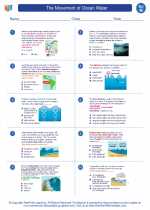The Movement of Ocean Water
Ocean water is constantly in motion, driven by a combination of factors such as wind, temperature, the Earth's rotation, and the shape of the ocean basins. This movement plays a crucial role in regulating Earth's climate, distributing heat around the globe, and influencing weather patterns.
Factors Affecting the Movement of Ocean Water
- Wind: Wind is one of the primary driving forces of ocean water movement. The friction between the air and the ocean's surface causes the water to move in the same direction as the wind.
- Temperature and Density: Variations in water temperature and density lead to the movement of ocean water. Warm, less dense water tends to rise, while cold, dense water sinks, creating currents and circulation patterns.
- Coriolis Effect: The Earth's rotation causes the Coriolis effect, which deflects moving objects, including ocean currents, to the right in the Northern Hemisphere and to the left in the Southern Hemisphere.
- Shape of the Ocean Basins: The shape and topography of the ocean basins influence the direction and strength of ocean currents. Narrow passages and the presence of continents can redirect and intensify currents.
Types of Ocean Currents
Ocean currents can be broadly classified into two main types: surface currents and deep ocean currents.
Surface Currents
Surface currents are driven primarily by wind and are located in the upper layer of the ocean. These currents play a significant role in distributing heat around the planet and can influence regional climates and weather patterns.
Deep Ocean Currents
Deep ocean currents, also known as thermohaline currents, are driven by differences in water density and temperature. These currents move slowly and can transport vast amounts of water and heat around the globe, playing a critical role in regulating Earth's climate.
Effects of Ocean Water Movement
The movement of ocean water has a wide range of effects, including:
- Regulating global temperatures through the redistribution of heat
- Influencing weather patterns and precipitation
- Affecting marine ecosystems and the distribution of marine life
- Playing a role in the transportation of nutrients and sediment
- Impact on human activities such as shipping, fishing, and coastal erosion
Study Guide
To understand the movement of ocean water, it's important to grasp the key concepts and factors that drive ocean currents. Here are some study tips and questions to help you master this topic:
- Review the factors that influence the movement of ocean water, including wind, temperature, the Coriolis effect, and the shape of ocean basins.
- Explore the differences between surface currents and deep ocean currents, and how each type of current is formed and driven.
- Examine the global patterns of ocean currents and their impact on climate and weather systems.
- Discuss the effects of ocean water movement on marine life, ecosystems, and human activities.
- Consider real-world examples of ocean currents and their significance, such as the Gulf Stream in the Atlantic Ocean or the Antarctic Circumpolar Current in the Southern Ocean.
By understanding the movement of ocean water, you can gain insights into the interconnected systems that shape our planet's climate and environment.
.◂Science Worksheets and Study Guides Eighth Grade. The Movement of Ocean Water

 Worksheet/Answer key
Worksheet/Answer key
 Worksheet/Answer key
Worksheet/Answer key
 Worksheet/Answer key
Worksheet/Answer key
 Vocabulary/Answer key
Vocabulary/Answer key
 Vocabulary/Answer key
Vocabulary/Answer key
